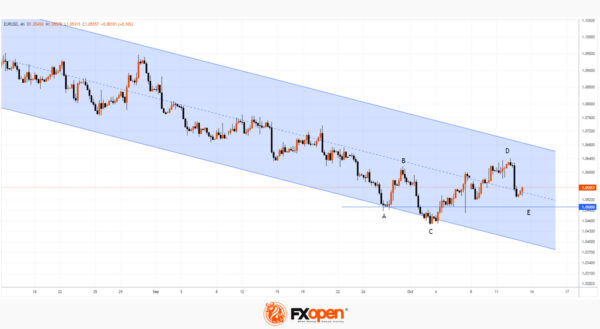Yesterday, another indicator of inflation in the United States was published — the CPI (Consumer Price Index). Like the PPI (Producer Price Index), the values of which were published on Wednesday, the CPI index indicated that inflation in the US remains stable (actual = 3.7%, forecast = 3.6%, a month earlier = 3.7%, two months earlier = 3.2%), however, this time, the reaction of market participants was sharper:
→ the stock market declined;
→ gold fell in price (although buyers in the Asian session on Friday contributed to the recovery);
→ the dollar index rose sharply.
Before the publication of news about inflation, the probability of a rate hike at the December Fed meeting was at 28%, but now it is 40%. The thesis “higher rates for a longer time” has returned to relevance.
For a technical analyst, changes in sentiment and spikes in volatility provide a new piece of valuable information. Let’s take the EUR/USD chart for example.
Yesterday’s news reversed the course from top to bottom, with the price of the euro falling towards the important level of 1.0500:
→ it is a round level, so it has a psychological effect;
→ at the end of September (A), level 1.05 served as a support for a rebound to top B;
→ after a slight dip below the 1.05 level in October, which can be interpreted as a false bearish breakout, the bulls demonstrated the ability to form a C→D rally — quite stable for the current downward channel (shown in blue).
The bearish impulse that appeared after yesterday’s news created intrigue — will the level of 1.05 be able to resist? If yes, we can see the inverted head-and-shoulders pattern as the basis for an upward exit from a protracted bearish trend.
This article represents the opinion of the Companies operating under the FXOpen brand only. It is not to be construed as an offer, solicitation, or recommendation with respect to products and services provided by the Companies operating under the FXOpen brand, nor is it to be considered financial advice.













